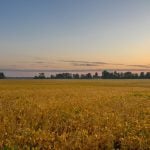“Highly productive” farmland continued to be a hot commodity in most parts of Canada during the first half of this year, according to Farm Credit Canada’s twice-yearly farmland values report.
Overall, the Crown ag finance firm said in its report Monday, the average value of farmland in Canada rose three per cent during the first half of 2010, following gains of 3.6 and 2.9 per cent in the previous two periods.
Among the provinces, Ontario posted the highest average increase at 4.3 per cent over the first half of 2010 ending June 30. British Columbia was the only province reporting a drop in average farmland values, down 0.9 per cent during the same period.
Read Also

China seeks improved ties with Canada amid rising trade tensions
China called on Friday for steps to improve bilateral ties with Canada, saying there were no deep-seated conflicts of interest, following a spike in trade tensions with many of Beijing’s Western trade partners this year.
“The prices paid for farmland today often reflect the conditions and events experienced by producers over the past six to 12 months,” Michael Hoffort, FCC’s senior vice-president for portfolio and credit risk, said in a release.
“It’s important for buyers to consider those things in determining whether to purchase and what price to pay.”
With competition strong for good farmland, FCC is also seeing “various types of land ownership, which provides farmers with a choice about how they want to operate their business,” FCC senior ag economist Jean-Philippe Gervais said in the same release.
For example, he said, “some producers choose not to own land to keep capital costs in check or because they can afford to rent better quality land closer to them. This diversity, and the fact that land is still a desirable asset, demonstrates the strength of agriculture over the long term, which is good for the industry.”
By province
Ontario’s 4.3 per cent increase followed gains of 3.3 and 2.8 per cent in the two previous reporting periods, FCC said. The province’s farmland values have been rising since 1993 and rose by an average of 0.5 per cent per month during the two last reporting periods.
The average value of farmland has risen since 2001 in Manitoba, increasing by 3.4 per cent in the first half of 2010 following gains of 5.9 and 5.5 per cent in the two previous reporting periods, FCC said. Increases since mid-2009 have come at an average rate of 0.8 per cent per month.
Also rising or remaining stable since 2001, the average value of farmland in Nova Scotia increased by 3.1 per cent in the first half of 2010, following gains of 1.4 and 4.2 per cent in the two previous periods. Values have risen by an average of 0.5 per cent per month since Jan. 1, 2009.
Average farmland value in Alberta rose 2.9 per cent during the reporting period, at an average rate of 0.4 per cent per month, following gains of 3.8 and one per cent in the two previous periods, FCC said. Farmland values in Alberta have been rising since 1993.
Saskatchewan’s average farmland value also increased by 2.9 per cent in the first half of 2010, following 3.4 per cent increases in each of the two previous reporting periods. The province’s farmland values have been rising since 2002, and by an average of 0.5 per cent per month during the last 12 months.
Quebec, which hasn’t seen a decrease in its average farmland values in the past 25 years, posted a 2.3 per cent in the first half of 2010, following gains of 1.3 and 4.3 per cent in the two previous periods, FCC said. The province’s average value increased by an average of 0.6 per cent per month during the two last reporting periods.
The average value of farmland in Newfoundland and Labrador rose 0.7 per cent during the reporting period, having remained flat in the last half of 2009 after rising 2.8 per cent in the first half of that year.
New Brunswick’s average farmland value remained flat during the first half of 2010, following gains of 2.5 and 5.6 per cent in the two previous reporting periods and a peak increase of 6.3 per cent in the last half of 2008, FCC said.
Prince Edward Island’s average value of farmland was also unchanged again during the first half of 2010, FCC said, as it was in the previous reporting period after slipping 1.4 per cent in the first half of 2009. P.E.I.’s average farmland values have dropped or remained flat in each FCC report since the last half of 2003.
B.C.’s decrease of 0.9 per cent in average farmland value in the first half of 2010 followed a 0.7 per cent drop in the first half of 2009 and unchanged values in the second half of that year, FCC said.
















